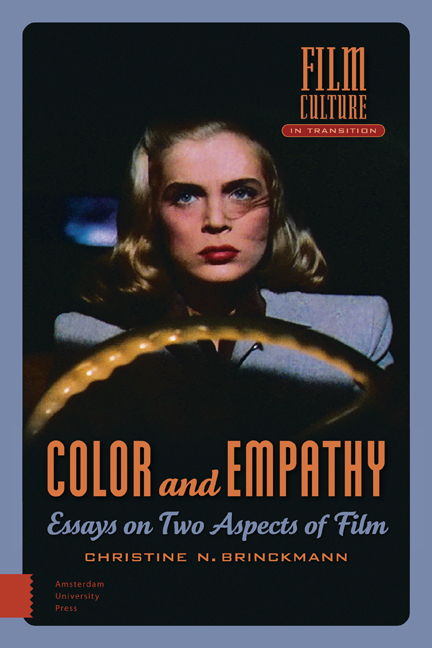Book contents
- Frontmatter
- Contents
- Preface
- Dedication
- Cinematic Color as Likeness and as Artifact: [2001]
- Chords of Color: [2006]
- The Tension of Colors in Colorized Silent Films: [2001]
- Structural Film, Structuring Color: Jenny Okun's Still Life: [1995]
- Desert Fury: A Film Noir in Color: [2012]
- The Work of the Camera: BEAU TRAVAIL: [2005]
- Empathy with the Animal: [1997]
- Motor Mimicry in Hitchcock: [1999]
- Abstraction and Empathy in the Early German Avant-garde: [1997]
- The Role of Empathy in Documentary Film: A Case Study: [2005]
- Genre Conflict in Tracey Emin’s Top Spot: [2007]
- Viewer Empathy and Mosaic Structure in Frederick Wiseman’s PRIMATE: [2009]
- CASTA DIVA: An Empathetic Reading: [2008]
- Publication Data
- Index of Films
- Index of Subjects
- Film Culture in Transition
The Role of Empathy in Documentary Film: A Case Study: [2005]
Published online by Cambridge University Press: 23 June 2021
- Frontmatter
- Contents
- Preface
- Dedication
- Cinematic Color as Likeness and as Artifact: [2001]
- Chords of Color: [2006]
- The Tension of Colors in Colorized Silent Films: [2001]
- Structural Film, Structuring Color: Jenny Okun's Still Life: [1995]
- Desert Fury: A Film Noir in Color: [2012]
- The Work of the Camera: BEAU TRAVAIL: [2005]
- Empathy with the Animal: [1997]
- Motor Mimicry in Hitchcock: [1999]
- Abstraction and Empathy in the Early German Avant-garde: [1997]
- The Role of Empathy in Documentary Film: A Case Study: [2005]
- Genre Conflict in Tracey Emin’s Top Spot: [2007]
- Viewer Empathy and Mosaic Structure in Frederick Wiseman’s PRIMATE: [2009]
- CASTA DIVA: An Empathetic Reading: [2008]
- Publication Data
- Index of Films
- Index of Subjects
- Film Culture in Transition
Summary
The following essay is a study of the processes of viewer empathy and associated feelings while watching a documentary. To my knowledge, the numerous studies on and theories of reception that have been published in the past ten years are almost exclusively based on the model of fiction. Noël Carroll, Dolf Zillmann, Murray Smith, Ed S. Tan, Alex Neill, Torben Grodal, Carl Plantinga, and Hans J. Wulff, to name just a few, all consider the fiction film when they record, analyze, and differentiate the complex processes of sympathy and empathy, viewer allegiance, participation, central and acentral imagining, emotional contagion, autonomic emotional arousal, affective empathy, and motor mimicry.
Usually, the more or less explicit focus of these discussions is the psychological-realistic variant of the fiction film. I will also refer to this tradition when I speak of “fiction film” here, for psychological realism is specifically tailored to immerse the viewers into the events and, depending on the genre and work, to grant emotional involvement of many sorts. Empathetic processes contribute significantly to intensify involvement.
The documentary depends less than the fiction film on illusionary experiences. Instead, it sets itself the tasks of conveying information about reality, exploring problems, providing arguments, and – at least in its tradition of social criticism – of altering the viewers’ consciousness in accordance with humanitarian, political, and moral principles. Although the documentary should be counted among the “discourses of sobriety,” to use Bill Nichols’ salient phrase, the films are often anything but dry. Many documentaries strive to involve the viewers in the events and to present interesting and sympathetic people who will become familiar as individuals. In this respect, the documentary is related to the fiction film, and in part adopts the latter’s narrative arc of a crisis or conflict that gets resolved in the end. But since documentaries and fiction films start out from different preconditions and requirements, differences as well as commonalities should be noted even where the subject matter and structure of events are comparable.
For the present study, it seemed advisable to select a documentary in which a conflict comes to pass and the parties collide in the process. I wanted to be able to pinpoint strong as well as ambivalent responses in the audience in order to be able to analyze when and how they evolve.
- Type
- Chapter
- Information
- Color and EmpathyEssays on Two Aspects of Film, pp. 173 - 198Publisher: Amsterdam University PressPrint publication year: 2014



